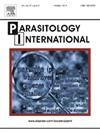印度-西太平洋棘蛛科新六鳃棘蛛科:丰富度、分布、饮食和当代命名问题。
IF 1.9
4区 医学
Q3 PARASITOLOGY
引用次数: 0
摘要
对印度-西太平洋棘虫科32种的数百个个体进行了检查,结果发现,1984年在大堡礁北部和南部(澳大利亚昆士兰州)、宁格鲁礁(西澳大利亚)、冲绳(日本)、新喀里多尼亚以及法属波利尼西亚的莫奥里亚和朗吉罗亚收集了与Neohexangitrema Machida属一致的吸虫。新hexangitrema属的标本主要采集于斑马属(Zebrasoma)的两个种,即Z. scopas (Cuvier)和Z. velifer (Bloch),较少采集于棘目(Acanthurus)的三个种。来自法属波利尼西亚的Z. scopas和A. nigricans (Linnaeus)的标本在形态和遗传上是不同的,本文将其描述为N. blairi N. sp。该物种似乎代表了法属波利尼西亚特有的一种不寻常的寄生虫。另外两种形态通常同时出现在至少一个其他地方的鱼类中,但不在法属波利尼西亚。其中第一种来自冲绳的宁格鲁礁,GBR和新喀里多尼亚,在形态和遗传上明显不同,被描述为N. phytophaga N. sp.该物种在消化道中经常有大量未消化的藻类,似乎是食草动物中的食草动物。第2种广泛分布的形态型包括来自Z. scopas和Z. velifer的标本,与1984年最初描述的来自日本南部的Z. velifer的N. zebrasomatis Machida一致。分子分析(cox1 mtDNA和ITS2和28S rDNA)一致表明,这些新标本代表了两个形态上的隐种,都感染了Z. scopas和Z. velifer,一个只在Ningaloo礁,另一个来自GBR。由于缺乏类型定位的分子数据,这两个物种目前都不能被肯定地鉴定为斑胸蚜。我们在此提出了两个分类群的新名称,来自GBR和新喀里多尼亚的物种为N. obscura N. sp,来自Ningaloo Reef的物种为N. cryptica N. sp。这一建议是在明确的理解下提出的,即两者中的一个很可能(但不一定)被证明是zebrasomatis的同义词。这种方法引起了人们对隐吸虫物种组合名称管理的关注。本文章由计算机程序翻译,如有差异,请以英文原文为准。

Neohexangitrema spp. (Trematoda: Microscaphidiidae) in Indo-West Pacific Acanthuridae: Richness, distribution, diet and contemporary naming issues
Examination of hundreds of individuals of 32 species of Acanthuridae from the Indo-West Pacific resulted in the collection of trematodes consistent with the genus Neohexangitrema Machida, 1984 from the northern and southern Great Barrier Reef (GBR, Queensland, Australia), Ningaloo Reef (Western Australia), Okinawa (Japan), New Caledonia, and Mo'orea and Rangiroa in French Polynesia. Specimens of Neohexangitrema spp. were primarily collected from two species of Zebrasoma, Z. scopas (Cuvier) and Z. velifer (Bloch), and less frequently from three species of Acanthurus. Specimens from Z. scopas and A. nigricans (Linnaeus) from French Polynesia are morphologically and genetically distinct and here described as N. blairi n. sp. This species appears to represent an unusual case of parasite endemism in French Polynesia. Two other morphotypes occurred, often together, in fishes from at least one of the other localities but not in French Polynesia. The first of these, from Ningaloo Reef, Okinawa, GBR and New Caledonia, is clearly morphologically and genetically distinct and is described as N. phytophagum n. sp. This species frequently has large amounts of undigested algae in the digestive tract and appears to be a herbivore in a herbivore. The second widespread morphotype comprised specimens from Z. scopas and Z. velifer consistent with N. zebrasomatis Machida, 1984 as originally described from Z. velifer from off southern Japan. Molecular analyses (cox1 mtDNA and ITS2 and 28S rDNA) consistently suggest that these new specimens represent two morphologically cryptic species, both infecting Z. scopas and Z. velifer, one only at Ningaloo Reef and the other from the GBR. Neither of these species can presently be positively identified as N. zebrasomatis given the lack of molecular data from the type-locality. We here propose new names for both taxa, N. obscurum n. sp. for the species from the GBR and New Caledonia and N. crypticum n. sp. for the species from Ningaloo Reef. This proposal is made with the explicit understanding that one of the two may well (but will not necessarily) prove a synonym of N. zebrasomatis. This approach draws attention to the developing issue of the management of the names of combinations of cryptic trematode species.
求助全文
通过发布文献求助,成功后即可免费获取论文全文。
去求助
来源期刊

Parasitology International
医学-寄生虫学
CiteScore
4.00
自引率
10.50%
发文量
140
审稿时长
61 days
期刊介绍:
Parasitology International provides a medium for rapid, carefully reviewed publications in the field of human and animal parasitology. Original papers, rapid communications, and original case reports from all geographical areas and covering all parasitological disciplines, including structure, immunology, cell biology, biochemistry, molecular biology, and systematics, may be submitted. Reviews on recent developments are invited regularly, but suggestions in this respect are welcome. Letters to the Editor commenting on any aspect of the Journal are also welcome.
 求助内容:
求助内容: 应助结果提醒方式:
应助结果提醒方式:


